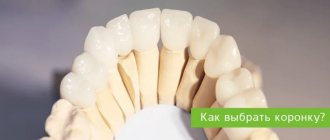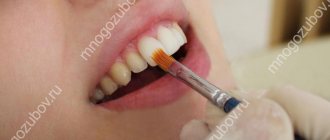Increased tooth wear – This is a process of increased tissue loss: first, the enamel becomes thinner, and then the inside of the teeth. Typically, the process of abrasion is constant - teeth gradually wear out throughout human life: first, the tooth enamel becomes thinner, and in old age it comes to the inner layers. Increased abrasion is a similar process that occurs at an accelerated rate: a real problem, and we will tell you how to deal with it.
The pathological loss of dentin and enamel is different in that it occurs much faster than with normal physiological abrasion. In this case, we talk about abnormal tooth wear, which is a recognized dental problem that mainly affects men over the age of 30. In this case, the decrease in the dental layer begins gradually, and as it progresses, it is no longer possible to influence the disease or cure it. That is why it is extremely important not to miss the initial stage of destruction of tooth enamel - so that tooth extraction, treatment and prosthetics are not required.
Causes of increased tooth wear
- The need to correct the bite: if, for example, the teeth “overlap” each other, or the upper teeth overlap the lower ones;
- general organic diseases: gastric ulcer, renal dysfunction, chronic alcoholism, vomiting during pregnancy, anorexia, esophagitis, etc.;
- unbalanced diet and consumption of unhealthy foods: excess food intake of citrus fruits and/or freshly squeezed juices, wine, spicy and pickled foods, herbal teas and carbonated drinks;
- hazardous work factor: this risk group includes employees of enterprises producing acids and other caustic chemical substances;
- factor of bad habits: frequent consumption of seeds, frequent use of a special brush to clean interdental spaces, habit of biting off floss with teeth;
- violation of teeth brushing technique and improper oral hygiene: addiction to abrasive and whitening pastes, excessive pressure on the teeth with a toothbrush and floss;
- Unsuccessful dental prosthetics: poorly made dentures provoke excessive pressure on the teeth or cause them to constantly come into contact with metal elements;
- Bruxism: This is the name given to involuntary grinding of teeth while sleeping.
Removing white spots on teeth at home
The appearance of a stain on a tooth is a reason for many to look for a solution on the Internet. The methods offered by online healers are harmless at best, but more often than not, dangerous. In the initial stages, it is difficult to say what causes the appearance of white streaks on the teeth. Therefore, advice to use fluoride-containing toothpaste will only worsen the condition of fluorosis. Gargling with herbs wastes time. With caries, this can result in serious inflammation in the oral cavity. Treating enamel with acids and alkalis can destroy it.
Pharmacy products are the safest, but without accurate diagnosis they can also cause harm.
Only a doctor can remove white spots on teeth, and not always. In case of systemic diseases, they can only be hidden.
Stages of dental destruction: when are consultation and diagnosis necessary?
By degree of destruction:
- Stage 1: there is a smooth smoothing of the tubercles on the enamel and the cutting edges of the teeth;
- Stage 2: tooth enamel is completely erased, the destruction process reaches dentin (the inner part of the tooth);
- Stage 3: the size of the part of the tooth located above the gum and clearly visible is only two-thirds of the norm;
- Stage 4: the crown of the tooth is completely destroyed and falls to the level of the gum.
Due to increased abrasion, the most unimaginable patterns may appear on the surface of tooth enamel, indicating damage to the enamel in the vertical, horizontal directions, in the form of dots, etc.
- Promotion
Dental treatment under anesthesia
Promotion for sedation in Moscow!
If you experience: — Severe stress during dental treatment — Fear of the sound of dental instruments — Time-limited visits to the dentist
old price
12 000 ₽
price
5 900 ₽
Free consultation RUB 5,900 for 30 minutes
Limited offer. Sign up for a free consultation. There are contraindications, consultation with a specialist is required.
- Promotion
Teeth whitening ZOOM
Promotion for teeth whitening in Moscow!
As a gift: - Prof. Oral hygiene – Whitening care set with individual trays
old price
40 000 ₽
price
19 900 ₽
Free consultation Sign up for a free consultation. There are contraindications, consultation with a specialist is required.
Proper brushing of teeth
Soft plaque begins to appear two hours after brushing your teeth. Sleep does not prevent it from appearing. It’s just that after hygiene procedures there are fewer bacteria in the mouth. That's why doing them correctly is so important.
- Wash the brush before use.
- Apply toothpaste no more than 0.5 cm for a child, and no more than 1 cm for an adult.
- Hold the brush head at an angle of forty-five degrees relative to the gums.
- Using rotational movements, begin to clean your teeth with your jaw closed.
- Then start cleaning the inner surface of the teeth.
- Then clean the coating of the chewing teeth using back and forth movements.
- The tongue and cheeks are cleaned last.
- The final stage is gum massage.
- Rinse the brush thoroughly and set it to dry.
- There is no need to press hard on the brush.
The bristles should be of medium hardness. Brushes with a small head volume allow you to perfectly clean plaque in hard-to-reach places.
The procedure should last at least five minutes, which is about five hundred movements. This brushing time is optimal because the fluoride elements contained in the paste begin to act three minutes after they hit the tooth surface. Therefore, to ensure that brushing your teeth is not pointless, you must follow all the rules described above. It is important to know that if you clean often, but incorrectly, there will be no result.
Dental floss - good or bad
Plaque appears between the teeth, where the bristles of the brush do not always reach. It needs to be removed with floss.
Its use helps clean the interdental space and surface of the teeth. The type of dental floss is selected according to the size of the gaps between the teeth. By using floss, you can prevent many gum diseases and the formation of tartar between your teeth.
What kind of toothpaste should it be?
There are two types of pastes:
- hygienic:
- therapeutic and prophylactic.
To remove plaque, you should pay attention to the content of abrasive elements. Allergy sufferers should pay attention to the fluoride and paraben content. The less the toothpaste foams, the less harmful substances it contains. It is better to give preference to pastes that contain natural ingredients.
Naturally, the choice of children's toothpaste should be approached with special care. It should not contain preservatives, dyes, and the paste must be age-appropriate.
In pursuit of whitening, you should not replace toothpastes with tooth powders. Using them damages the enamel and can only make things worse.
A soft white coating does not indicate the presence of any diseases. It occurs in everyone. The main task is its timely elimination. Although, frankly speaking, it is an aesthetic flaw.
Prevention in children begins with the appearance of the first tooth. Initially, children brush their teeth without toothpaste.
Doctors recommend seeking tartar removal services once a year. After the procedure, the teeth become a tone or even two lighter.
zubnoimir.ru
Classification of disease prevalence
With local abrasion, only individual teeth are affected - as a rule, against the background of some acquired factors; with generalized abrasion, this problem already affects the entire dentition, and such an anomaly is usually congenital.
Symptoms of increased tooth wear
- the appearance of tooth enamel changes, it becomes uneven, rough, and tubercles appear on it;
- the natural color of the teeth changes, they become almost translucent;
- teeth acquire increased sensitivity to the effects of cold and heat, to mechanical or chemical irritants;
- sharp edges form on the enamel, which can injure the mucous membrane on the inner surface of the lips and cheeks;
- the teeth are shortened, the lower third of the face decreases in size, and folds appear in the corners of the mouth;
- hearing loss occurs and the chewing process is disrupted.
Causes of tooth enamel destruction
- Bad habits: smoking, alcoholism, and regular consumption of energy drinks;
- Frequent consumption of sugar-containing products, which are especially active in destroying enamel;
- Drinking drinks with a lot of acid, especially lemon juice. This applies primarily to sparkling waters, which are also very sweet, as well as regular tea with lemon;
- Citrus fruits are also not very good for enamel, especially if eaten regularly;
- Poor nutrition usually leads to digestive problems and acid-base imbalance. Because of this, stomach acid often spills out of the stomach, which has a very negative effect on the teeth;
- It is quite harmful to drink hot food with cold water, or, conversely, to eat hot drinks with cold dishes. Such sudden temperature changes destroy the enamel, since it is not designed for them;
- With an incorrect bite, injury or incorrect treatment, the enamel can be damaged purely mechanically;
- With age, due to demineralization, the enamel thins on its own.
How to deal with tooth wear
For many patients, tooth wear is not a problem at all - until it begins to be accompanied by painful sensations. They have no idea that the process of destruction of enamel and dentin is irreversible, and the sooner it is detected, the higher the chance of at least slowing down its inevitable progression.
Measures to combat tooth wear should be comprehensive:
- Treat your gums and teeth in a timely manner: be sure to monitor the condition of all teeth and gums so that, if necessary, you can consult a doctor as quickly as possible for appropriate treatment of caries or other common diseases;
- regularly saturate tooth enamel with nutrients and minerals : for this purpose, apply special medications to it; you can also use protective mouth guards with vitamins, minerals and gels placed inside;
- correct the malocclusion: to change the incorrect position of several teeth, for example, “located” on top of each other and causing destruction of the enamel at the point of their contact, contact an orthodontist and take a course to correct the bite using braces;
- undergo treatment for bruxism: in the absence of pressure on the teeth, their condition will improve significantly, which is why it is so important to use protective mouthguards at night to reduce the load on the teeth due to clenching of the jaws, and also try to eliminate stressful situations;
- restore lost teeth: aesthetic dentistry will reduce the load on the remaining ones, the dentist will suggest you use a bridge, removable structure or dental implantation;
- Consult your doctor to have your dentures adjusted: Be sure to consult with your dentist and, if necessary, replace the old denture with a new one or allow a dental prosthetic specialist to adjust the position of the metal elements of the denture to reduce pressure on the enamel.
People working in hazardous industries are advised to change jobs if this negatively affects the condition of their teeth and the body as a whole. To restore the aesthetics of the dentition, today they use veneers and lumineers (the so-called thin ceramic linings that are fixed on the front surface of the teeth), or the familiar dental crowns, which allow, to a greater or lesser extent, to restore the visible part of the tooth above the gum.
Quick appointment Free consultation
Treatment of white spots on teeth
The treatment plan directly depends on the reasons for the appearance of white marks on the enamel. If a white spot appears on a tooth after whitening, remineralization is performed. Saturation of hard tissues with minerals is the basis of therapeutic measures for white spots on enamel.
The composition of the medications used by the doctor also depends on the diagnosis and symptoms.
For caries at the light spot stage, treatment consists of:
- remineralizing therapy;
- fluoridation;
- infiltration (Icon technology).
In the vast majority of cases, filling is not required at the initial stage.
Treatment of fluorosis and hypoplasia begins with mineralization. But it is necessary to understand that these are systemic diseases that affect teeth at the development stage. It is impossible to get rid of this pathology; treatment is symptomatic. Teeth whitening brings only a temporary and not very pronounced effect. If the white dots begin to change color, the best solution would be prosthetics. Veneers (thin overlays) are placed on the front teeth, and crowns are placed on the molars. Veneers are installed only on permanent teeth.
Removing dental plaque is a prerequisite for successful treatment.
Preventing Brown Plaque
Many people mistakenly believe that by brushing their teeth once a day, they protect themselves from possible oral diseases. This is absolutely not true. The more often you brush your teeth, the better. This is determined by the fact that the appearance of primary dental plaque begins after 2-4 hours after brushing your teeth. At the initial stage, saliva actively fights the negative effects of plaque. It prevents the acidic secretions of bacteria from damaging the enamel surface. However, after 4-6 hours, the plaque becomes much denser, and saliva can no longer penetrate through it. That is why one-time cleaning of teeth is not a way to reliably prevent the appearance of plaque, plaque and, as a result, tartar and other diseases.
To prevent the appearance of dark plaque on the inside of your teeth, you should train yourself to brush your teeth after every meal. Soft food fills microcracks and roughness on the surface, creating an excellent environment for the development of microorganisms. If you thoroughly clean your mouth after eating, there is no breeding ground for bacteria. If you do not have the opportunity to brush your teeth with a brush and toothpaste after each meal, you can use mouthwash or even plain water.
An important component of the health of the oral cavity and the body as a whole is diet. Hard dietary fiber allows the surface of the teeth to clean itself, while soft food, on the contrary, clogs the teeth and gums. In addition to introducing solid foods into your diet, you also need to take care of the required amount of useful elements and vitamins. Thus, it is recommended to include cereals, nuts, carrots, apples, flour products and dairy items in the menu.
Methods for restoring tooth enamel
Tooth enamel is a tissue that does not repair itself. Therefore, to eliminate the consequences of tooth enamel destruction, it is necessary to resort to modern medicine.
Fluoridation
Most often, fluoridation - coating teeth with fluoride-containing preparations. Fluoridation has the most reasonable price, but this procedure will have to be carried out several times. Despite the fact that fluoridation seems like an easy procedure, it is not recommended to apply fluoride-containing gels and varnishes at home yourself - this should be done by an experienced doctor, since the slightest contact of fluorides in the throat or mucous membranes of the mouth can lead to serious complications. Fluoridation, as the name implies, saturates the enamel with fluoride and helps to strengthen and restore it.
Remineralization
Remineralization is the saturation of tooth enamel with various minerals due to the treatment of teeth with special preparations. In some ways, remineralization may seem similar to fluoridation, but the principle is slightly different. During remineralization, a special protective film is formed on the surface of the tooth, which strengthens the enamel and prevents it from being destroyed. At the same time, the composition of the film is very close to real tooth enamel.
Enamel implantation
Enamel implantation is an innovative technique for restoring tooth enamel. It is used to restore fairly large damaged areas and to achieve a certain cosmetic effect.
During enamel implantation, the specialist applies a composition to the teeth that is very similar in structure to tooth enamel. This “implant” is connected to the dental tissue at the molecular level due to the proximity of the structures, and for a long time performs the functions of full-fledged natural enamel.
This method is the most effective, but it is still too expensive due to the high cost of this very implant composition.
Causes of brown plaque
A distinctive feature of brown plaque from other more harmless forms is its rapid spread throughout the oral cavity. It affects not only the enamel, but also the gums, mucous surfaces of the lips, and tongue. The development of this type of dental plaque is fraught with the rapid appearance of serious diseases, such as periodontal disease, as well as the appearance of caries with serious complications.
There are different types of brown plaque. Among them:
- subgingival,
- dentogingival,
- proximal (located on the contact surfaces of the teeth).
Subgingival plaque covers the mucous surface of the mouth and the lower part of the gums. Dental plaque develops on the smooth surface of the tooth (from the outside and inside), and can descend to the edge of the gum. Such dental deposits are most noticeable, as they are located on the visible part of the enamel. Proximal plaque is dangerous because, located on the contact surface of the tooth, it occurs directly during chewing. In other words, the cause of brown teeth on the inside is a dark plaque that affects the inside of the teeth.
Dark plaque on teeth can be caused by reasons such as:
- individual characteristics of the human body (predisposition);
- specific structure of the jaw and arrangement of teeth;
- individual component composition of saliva;
- inflammatory processes in the oral cavity;
- poor diet, including too many acidic foods as well as soft foods;
- improper chewing habits.
Brown plaque on teeth is also a big aesthetic problem. First of all, you can immediately forget about a “snow-white smile”, since plaque is very noticeable both on the visible and on the inner areas of the teeth. In addition, it is also a source of bad breath as well as an acrid taste.
Self-restoration of tooth enamel
In fact, it is impossible to fully restore tooth enamel at home, but if the damage is minor, then you can try to compensate for the deficiency of trace elements and minerals - this will still have some positive effect.
Typically, for home enamel restoration, toothpastes with increased amounts of fluoride are used. While brushing, you should keep the toothpaste in your mouth so that the process of nourishing your teeth is more effective.
Attention should also be paid to nutrition. The diet should contain more foods with vitamin D and calcium, especially dairy products, various cabbage, juices and muesli.
Products for self-fluoridation or remineralization of enamel have recently appeared on sale; they are usually available in the form of applications or mouth guards. It is worth noting that you should still consult your dentist before using them.











